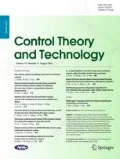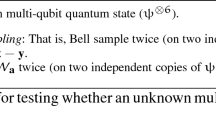Abstract
A network of observers is considered, where through asynchronous (with bounded delay) communications, they cooperatively estimate the states of a linear time-invariant (LTI) system. In such a setting, a new type of adversary might affect the observation process by impersonating the identity of the regular node, which is a violation of communication authenticity. These adversaries also inherit the capabilities of Byzantine nodes, making them more powerful threats called smart spoofers. We show how asynchronous networks are vulnerable to smart spoofing attack. In the estimation scheme considered in this paper, information flows from the sets of source nodes, which can detect a portion of the state variables each, to the other follower nodes. The regular nodes, to avoid being misguided by the threats, distributively filter the extreme values received from the nodes in their neighborhood. Topological conditions based on strong robustness are proposed to guarantee the convergence. Two simulation scenarios are provided to verify the results.







Similar content being viewed by others
Change history
22 September 2023
An Erratum to this paper has been published: https://doi.org/10.1007/s11768-023-00154-x
Notes
The term partial asynchrony refers to the case where nodes share some level of synchrony by having the same sampling times; however, they make updates at different times based on bounded information delays [26].
We used the term broadcast considering the case of wireless networks. Regular nodes may transmit the information to their known outgoing neighbors in wired networks.
References
Daswani, N., Kern, C., & Kesavan, A. (2007). Foundations of Security: What Every Programmer Needs to Know. Dreamtech Press.
Zheng, G., Ma, H.-T., Cheng, C., & Tu, Y.-C. (2012). Design and logical analysis on the access authentication scheme for satellite mobile communication networks. IET Information Security, 6(1), 6–13.
Villalba, L. G., Matesanz, J. G., Canas, D. R., & Orozco, A. S. (2011). Secure extension to the optimised link state routing protocol. IET Information Security, 5(3), 163–169.
Ueda, H., Kurachi, R., Takada, H., Mizutani, T., Inoue, M., & Horihata, S. (2015). Security authentication system for in-vehicle network. SEI Technical Review, 81, 5–9.
Sun, C., Hu, C., & Liu, B. (2012). Sack2: Effective SYN flood detection against skillful spoofs. IET Information Security, 6(3), 149–156.
Magiera, J., & Katulski, R. (2015). Detection and mitigation of GPS spoofing based on antenna array processing. Journal of Applied Research and Technology, 13(1), 45–57.
Su, J., He, J., Cheng, P., & Chen, J. (2016). A stealthy GPS spoofing strategy for manipulating the trajectory of an unmanned aerial vehicle. IFAC-PapersOnline, 49(12), 291–296.
Dutta, A., & Langbort, C. (2017). Confiscating flight control system by stealthy output injection attack. Journal of Aerospace Information Systems, 14(4), 203–213.
Zhang, T., & Zhu, Q. (2017). Strategic defense against deceptive civilian GPS spoofing of unmanned aerial vehicles. In Proceedings of international conference on decision and game theory for security (pp. 213–233). Vienna, Austria.
Gil, S., Kumar, S., Mazumder, M., Katabi, D., & Rus, D. (2017). Guaranteeing spoof-resilient multi-robot networks. Autonomous Robots, 41(6), 1383–1400.
Renganathan, V., & Summers, T. (2017). Spoof resilient coordination for distributed multi-robot systems. In Proceedings of international IEEE symposium on multi-robot and multi-agent systems (MRS) (pp. 135–141). Los Angeles, CA, USA.
Lynch, N. A. (1996). Distributed Algorithms. Morgan Kaufmann.
Dibaji, S.M., Safi, M., & Ishii, H. (2019). Resilient distributed averaging. In Proceedings of American control conference (pp. 96–101). Philadelphia, PA.
Bonnet, F., Défago, X., Nguyen, T. D., & Potop-Butucaru, M. (2016). Tight bound on mobile Byzantine agreement. Theoretical Computer Science, 609, 361–373.
Alexandru, A. B., Pequito, S., Jadbabaie, A., & Pappas, G. J. (2017). On the limited communication analysis and design for decentralized estimation. In Proceedings of IEEE conference on decision and control (pp. 1713–1718). Melbourne, VIC, Australia.
Khan, U. A., Kar, S., Jadbabaie, A., & Moura, J. M. (2010). On connectivity, observability, and stability in distributed estimation. In Procedings of IEEE conference on decision and control (pp. 6639–6644). Atlanta, GA, USA.
Park, S., & Martins, N. C. (2017). Design of distributed LTI observers for state omniscience. IEEE Transactions on Automatic Control, 62(2), 561–576.
Wang, L., & Morse, A. (2017). A distributed observer for a time-invariant linear system. In Proceedings of American control conference (pp. 2020–2025). Seattle, WA, USA.
Mitra, A., & Sundaram, S. (2018). Resilient distributed state estimation for LTI systems.arXiv preprint. arXiv:1802.09651.
Mitra, A., & Sundaram, S. (2018). Secure distributed state estimation of an LTI system over time-varying networks and analog erasure channels. In Proceedings of American control conference (pp. 6578–6583). Milwaukee, WI, USA.
Dibaji, S. M., & Ishii, H. (2017). Resilient consensus of second-order agent networks: Asynchronous update rules with delays. Automatica, 81, 123–132.
Dibaji, S. M., Ishii, H., & Tempo, R. (2017). Resilient randomized quantized consensus. IEEE Transactions on Automatic Control, 63(8), 2508–2522.
Dibaji, S. M., Pirani, M., Flamholz, D. B., Annaswamy, A. M., Johansson, K. H., & Chakrabortty, A. (2019). A systems and control perspective of CPS security. Annual Reviews in Control, 47, 394–411.
LeBlanc, H. J., Zhang, H., Koutsoukos, X., & Sundaram, S. (2013). Resilient asymptotic consensus in robust networks. IEEE Journal on Selected Areas in Communications, 31(4), 766–781.
Pelc, A., & Peleg, D. (2005). Broadcasting with locally bounded Byzantine faults. Information Processing Letters, 93(3), 109–115.
Bertsekas, D. P., & Tsitsiklis, J. N. (1989). Parallel and Distributed Computation: Numerical Methods. Prentice Hall.
Author information
Authors and Affiliations
Corresponding author
Rights and permissions
Springer Nature or its licensor (e.g. a society or other partner) holds exclusive rights to this article under a publishing agreement with the author(s) or other rightsholder(s); author self-archiving of the accepted manuscript version of this article is solely governed by the terms of such publishing agreement and applicable law.
About this article
Cite this article
Safi, M., Dibaji, S.M. & Ishii, H. Cooperative distributed state estimation: resilient topologies against smart spoofers. Control Theory Technol. 20, 488–503 (2022). https://doi.org/10.1007/s11768-022-00118-7
Received:
Revised:
Accepted:
Published:
Issue Date:
DOI: https://doi.org/10.1007/s11768-022-00118-7




